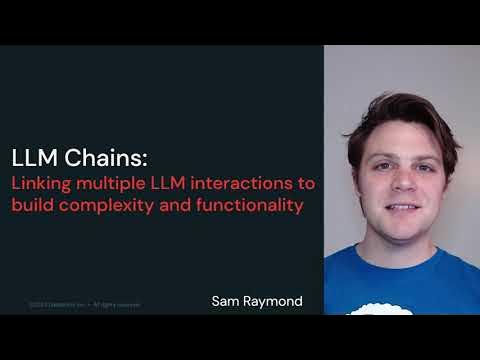LLM Module 3 - Multi-stage Reasoning | 3.2 Module Overview
Summary
TLDRIn this module, you'll learn how to combine large language models (LLMs) with tools like LangChain and vector databases to build powerful, modular applications. The focus is on creating multi-stage workflows where LLMs handle tasks like summarization and sentiment analysis in a streamlined, systematic way. Using LangChain, you’ll learn to integrate LLMs from different providers and build complex pipelines. The module emphasizes the importance of breaking tasks down into manageable steps, ensuring flexibility and scalability in applications. By the end, you'll understand how to build reusable, modular LLM systems for a variety of tasks.
Takeaways
- 😀 LLMs (Large Language Models) are powerful tools for NLP tasks such as summarization, translation, and classification.
- 😀 The combination of LLMs with vector databases can enhance search capabilities in applications.
- 😀 LangChain is a tool used to integrate LLMs from various providers, such as OpenAI and Hugging Face, into workflows.
- 😀 Complex workflows can be built using LangChain, where LLMs serve as the central 'brain' and various tools (like web searching and Python environments) are used to solve tasks.
- 😀 LLMs have limitations, such as dealing with complex multi-step workflows and large input sequences that exceed model capacities.
- 😀 In typical applications, an LLM is only one part of an end-to-end workflow, and it should seamlessly integrate with other components of the system.
- 😀 A modular design for LLM-based workflows allows flexibility, such as replacing one LLM with another without disrupting the entire system.
- 😀 An example workflow is summarizing articles and analyzing sentiment. This could be handled more effectively by splitting the tasks between different LLMs (one for summarization and one for sentiment analysis).
- 😀 Breaking down a task into smaller, more manageable steps helps prevent issues with input sequence lengths that might overwhelm a model.
- 😀 The goal of modular LLM workflows is to enable reusable tools, making it easier to process new articles or data without rebuilding the entire system.
Q & A
What is the focus of this module?
-This module focuses on combining large language models (LLMs) with other tools like LangChain to enhance the applications developers can build. It covers creating modular workflows, leveraging LLMs from different providers, and using agents to build complex logical flow patterns.
What tools will be explored in this module to build LLM pipelines?
-The module will explore LangChain to build LLM pipelines. LangChain allows developers to combine LLMs from various providers, including OpenAI and Hugging Face, to create complex workflows.
How can LangChain be used in building LLM pipelines?
-LangChain helps in building pipelines by integrating LLMs from different providers into a coherent workflow. This allows developers to create applications where LLMs handle different stages of tasks, such as summarization or sentiment analysis.
What is a key benefit of using LangChain in LLM-based applications?
-The key benefit of using LangChain is its ability to modularize the workflow, meaning developers can easily swap LLMs in and out of the pipeline without disrupting the overall system.
What are the limitations of large language models (LLMs) discussed in the module?
-LLMs are fantastic at solving traditional NLP tasks like summarization and translation, but most workflows require more than simple input-output responses. Additionally, LLMs can face challenges when dealing with long input sequences or complex, multi-step tasks.
What is a better strategy for summarizing and analyzing the sentiment of articles, according to the module?
-A better strategy is to process one article at a time, using a summarization LLM first, and then passing the summary to a sentiment analysis LLM. This approach allows for more manageable tasks and avoids overwhelming the LLM with large inputs.
Why is processing articles one by one beneficial?
-Processing articles one by one prevents overwhelming the LLM with large input sequences. It allows the LLM to focus on one task at a time—summarizing the article and then analyzing the sentiment of the summary—thereby improving performance and efficiency.
What problem does the module aim to solve by breaking up tasks across multiple LLMs?
-By breaking tasks into manageable steps and using different LLMs for each task (e.g., summarization and sentiment analysis), the module aims to avoid overloading the LLMs with too much information at once, thus improving the modularity and scalability of workflows.
What does the module suggest as a solution to the limitations of using a single LLM for all tasks?
-The solution suggested is to use multiple LLMs for different tasks, such as one for summarization and another for sentiment analysis, in a modular workflow. This makes the system more flexible and scalable.
What will the next video in the module focus on?
-The next video will focus on chaining together prompts and LLMs, demonstrating how to pass articles one by one through a systematic process to achieve the desired outputs, such as summaries and sentiment analysis.
Outlines

Dieser Bereich ist nur für Premium-Benutzer verfügbar. Bitte führen Sie ein Upgrade durch, um auf diesen Abschnitt zuzugreifen.
Upgrade durchführenMindmap

Dieser Bereich ist nur für Premium-Benutzer verfügbar. Bitte führen Sie ein Upgrade durch, um auf diesen Abschnitt zuzugreifen.
Upgrade durchführenKeywords

Dieser Bereich ist nur für Premium-Benutzer verfügbar. Bitte führen Sie ein Upgrade durch, um auf diesen Abschnitt zuzugreifen.
Upgrade durchführenHighlights

Dieser Bereich ist nur für Premium-Benutzer verfügbar. Bitte führen Sie ein Upgrade durch, um auf diesen Abschnitt zuzugreifen.
Upgrade durchführenTranscripts

Dieser Bereich ist nur für Premium-Benutzer verfügbar. Bitte führen Sie ein Upgrade durch, um auf diesen Abschnitt zuzugreifen.
Upgrade durchführenWeitere ähnliche Videos ansehen

What is LangChain?

LLM Module 3 - Multi-stage Reasoning | 3.4 LLM Chains

Roadmap to Learn Generative AI(LLM's) In 2024 With Free Videos And Materials- Krish Naik

LangChain and n8n

LangChain Explained in 13 Minutes | QuickStart Tutorial for Beginners

What is LangChain? 101 Beginner's Guide Explained with Animations
5.0 / 5 (0 votes)
